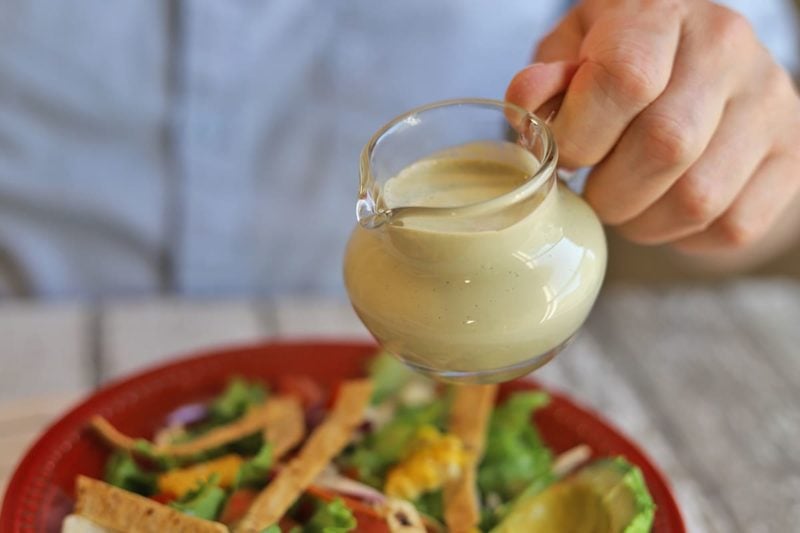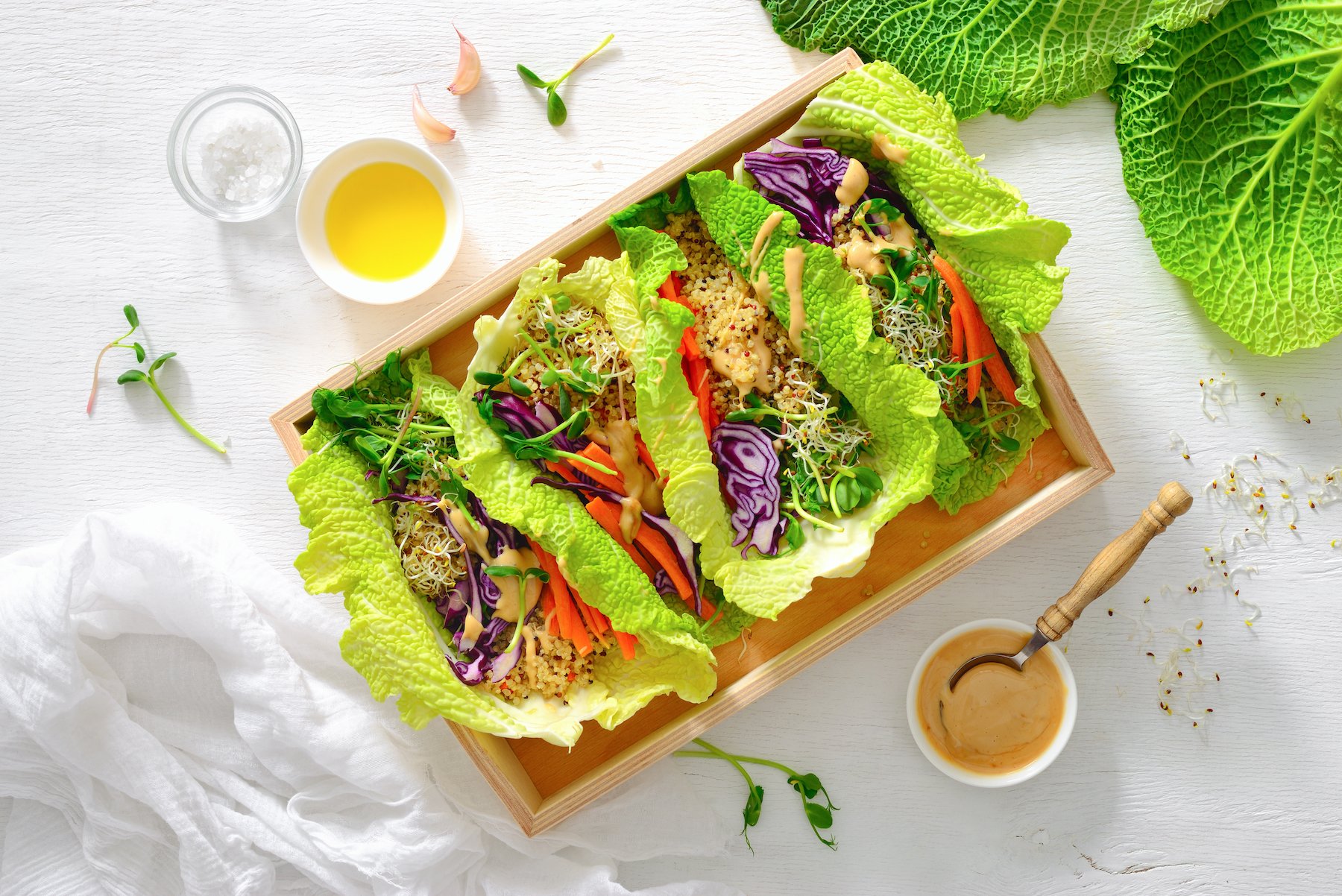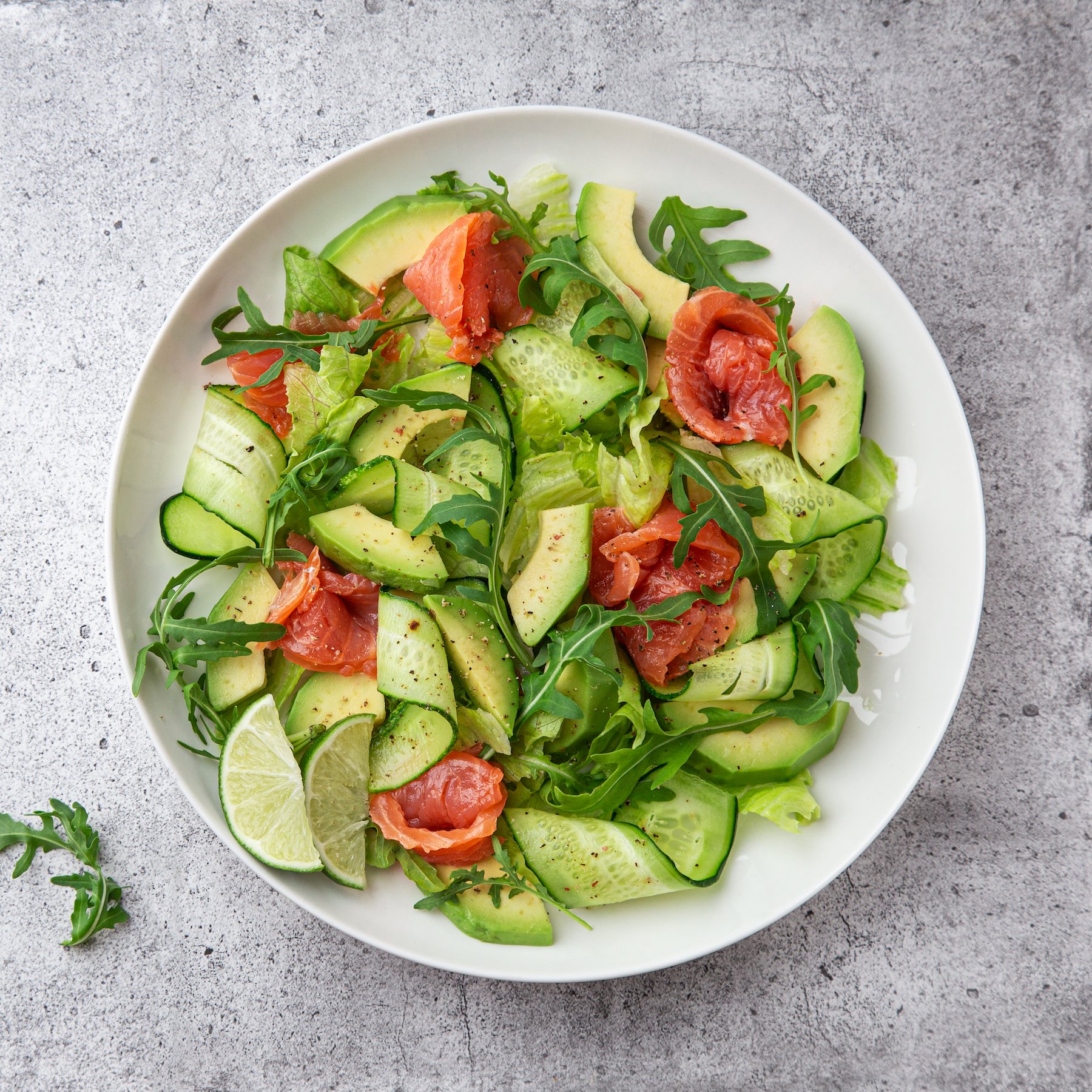Salads are a delicious way to get your veggies and all the important nutrients they contain. And tossing your bowl with a flavorful dressing can add even more benefits: Our bodies need fat to absorb certain disease-fighting vitamins and antioxidants. According to a study published in the American Journal of Clinical Nutrition, people had higher blood levels of lutein, lycopene, beta-carotene, and vitamin E when they ate a salad drizzled with an oil-containing dressing than when they ate it with an oil-free dressing.
“The key is dressing your salad the right way. Many bottled brands are made with processed seed oils, which may contribute to the inflammation and weight gain that can lead to insulin resistance, and also often contain added sweeteners, sometimes with more sugar per serving than a chocolate chip cookie.”
But the key is dressing your salad the right way. Many bottled brands are made with processed seed oils, which may contribute to the inflammation and weight gain that can lead to insulin resistance. These dressings also often contain added sweeteners (sometimes with more sugar per serving than a chocolate chip cookie) that can cause your blood sugar to spike and crash.
The Problem with Typical Salad Dressing
To help you sort the good from the bad, let’s unpack common ingredients in typical store-bought salad dressings and how they impact your blood sugar:
- Refined seed oils: The main ingredient in many bottled dressings is a processed seed oil, such as soybean or canola oil. These refined oils can be high in an omega-6 fatty acid called linoleic acid. Over time, Americans have increased the amount of omega 6 they consume as soybean oil became the dominant source of linoleic acid in packaged goods such as salad dressing. At the same time, they’ve eaten less anti-inflammatory omega 3. Some research points to this high ratio of omega 6s to omega 3s as a driver of chronic disease. It can trigger inflammation, which may set the stage for insulin resistance, Type 2 diabetes, cardiovascular disease, and cancer.
- Added sugars: Even savory salad dressings can sneak in cane sugar, corn syrup, honey, and other sweeteners to enhance the flavor. Some brands deliver 11 grams of sugar per serving. That’s the equivalent of sprinkling nearly three teaspoons of table sugar onto your salad. This added sugar can cause an increase in blood glucose, which, over time, may set the stage for insulin resistance. Although a well-balanced salad will have fiber and protein to slow the digestion and release of sugars in the bloodstream, added sugars can still overwhelm your body’s metabolism and lead to a spike.
- Xantham gum: Made from fermented sugar, this white powder is used to thicken and stabilize dressings. Although it’s safe to eat, it can cause stomach discomfort in certain people.
- Other additives: Certain salad dressings, such as ranch and Caesar, use titanium dioxide to make them appear a brighter shade of white. Studies suggest that this additive may cause DNA damage and inflammation, which can interfere with your blood glucose levels. It’s one of the food additives banned in other countries that you’re better off avoiding. Other dressings, such as French and Catalina, use artificial dyes for their hues. Some of these, such as red 40 and blue 1, may cause allergic reactions in some people.
Bottled Dressings to Try
When you want the convenience of premade dressing, consider one of these brands:
- Primal Kitchen: This lineup of Whole30- and keto-approved dressings is free of added sugars and soybean and canola oils. Instead, they’re made with avocado oil. Choose from a dozen flavors, including green goddess and cilantro lime.
- Mother Raw: Made with extra-virgin olive oil, these dressings are free from artificial additives, and the Caesar, Greek, and Mediterranean flavors contain zero added sugars.
- Garlic Gold: Get a garlicky kick from the Meyer lemon, red wine, or balsamic vinaigrettes, which are made with garlic-infused extra-virgin olive oil and organic spices.
Build a Better Dressing
A surefire way to score a healthy dressing is by making your own. A drizzle of olive oil and vinegar or lemon juice is a smart pick, but it’s not the only option. Follow these steps to blend your own topping:
- Start with a healthy fat. Fat can help increase your absorption of certain fat-soluble nutrients in your salad vegetables. Choose a fat that benefits your metabolic health: Avocado oil is a good choice that’s high in oleic acid, while adding extra-virgin olive oil to a meal is shown to improve blood glucose and cholesterol levels.
- Blend in creaminess. If you like silky-smooth dressing, use one of these nutrient-dense ingredients as a base: Tahini, a paste made from sesame seeds, adds a nutty flavor and an anti-inflammatory compound called sesamin. Avocado contains fiber and a number of nutrients, such as potassium and lutein, that help keep inflammation and blood glucose in check. Soaking and blending nuts (such as cashews or macadamia nuts) creates a rich cream, plus, nuts are high in protein, fiber, and healthy fats, and research shows that eating nuts regularly may improve metabolic health and reduce the risk of Type 2 diabetes.
- Pick a vinegar. A little acid helps balance a dressing and may help lower blood sugar. One study found that adding vinegar to a meal helped reduce insulin levels and glucose spikes afterward. That’s because vinegar may slow the breakdown of carbs. Different vinegars have unique flavors: Balsamic vinegar has a complex sweetness and a dose of sugar (3 grams per tablespoon). Red wine and apple cider vinegars, which have a sweet sharpness, as well as neutral-tasting white vinegar are zero-sugar options. Skip rice vinegar, which is higher in sugar (8 grams per tablespoon).
- Add some flavor. Now that you have a dressing base, play around with flavor profiles. Spices and herbs—such as rosemary, sage, and oregano—provide disease-fighting antioxidants, while studies show that ginger and turmeric may protect against the cellular damage that leads to inflammation. Like a spicy kick? Add a dash of cayenne pepper, which may help lower blood sugar levels.
9 Healthy Salad Dressing Recipes to Try
Whether you’re in the mood for a tangy vinaigrette or creamy Caesar, we’ve got you covered. These tasty dressings are simple to make and good for your metabolic health.
- Creamy Garlic Dressing: This dressing pairs garlic—which is high in disease-fighting antioxidants—with creamy macadamia nuts, vinegar, and olive oil. Toss it with a salad, or serve it as a sauce for chicken, meat, or vegetables.
- Lemon Apple Cider Vinaigrette: Apple cider vinegar and stevia, a natural sweetener, give this citrusy vinaigrette its sweetness.
- Creamy Avocado Dressing: Full of fiber and healthy fat, avocados are the star of this dressing. Serve it on a crisp romaine salad or as a dip with crudites.
- Vegan Caesar Dressing: This classic gets its creaminess from raw cashews instead of cream or eggs. Nutritional yeast adds B vitamins and a cheesy, savory flavor.
- Balsamic Herb Vinaigrette: Fresh basil and garlic liven up this tangy-sweet dressing.
- Low-Carb Keto Ranch Dressing: This recipe lightens up a favorite standby by using almond milk, sour cream, lemon juice, and plenty of spices.
- Creamy Cashew Dressing: Cashews give this oil-free dressing creaminess, while cilantro, garlic, and lemon juice give it zip.
- Lemon Garlic Tahini: Garlic and tahini have compounds that may help reduce inflammation. This creamy dressing pairs well with chicken, seafood, and cucumber and tomato salad.
- Keto Green Goddess: Made with avocado and avocado oil, this garlicky dressing is loaded with fresh basil and green onion.








